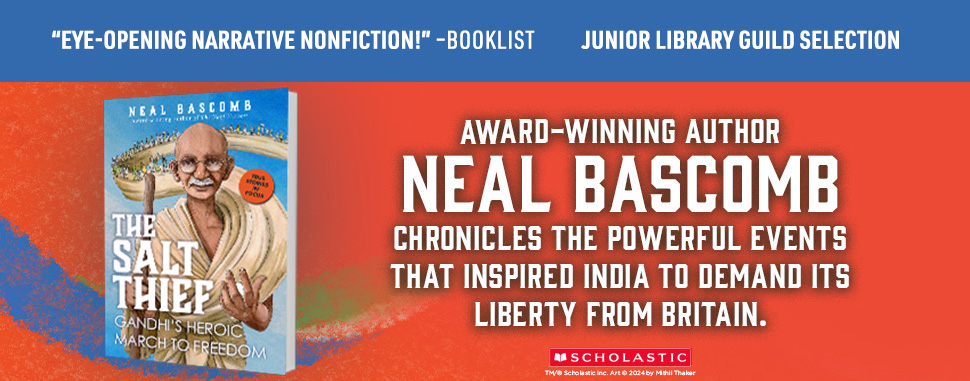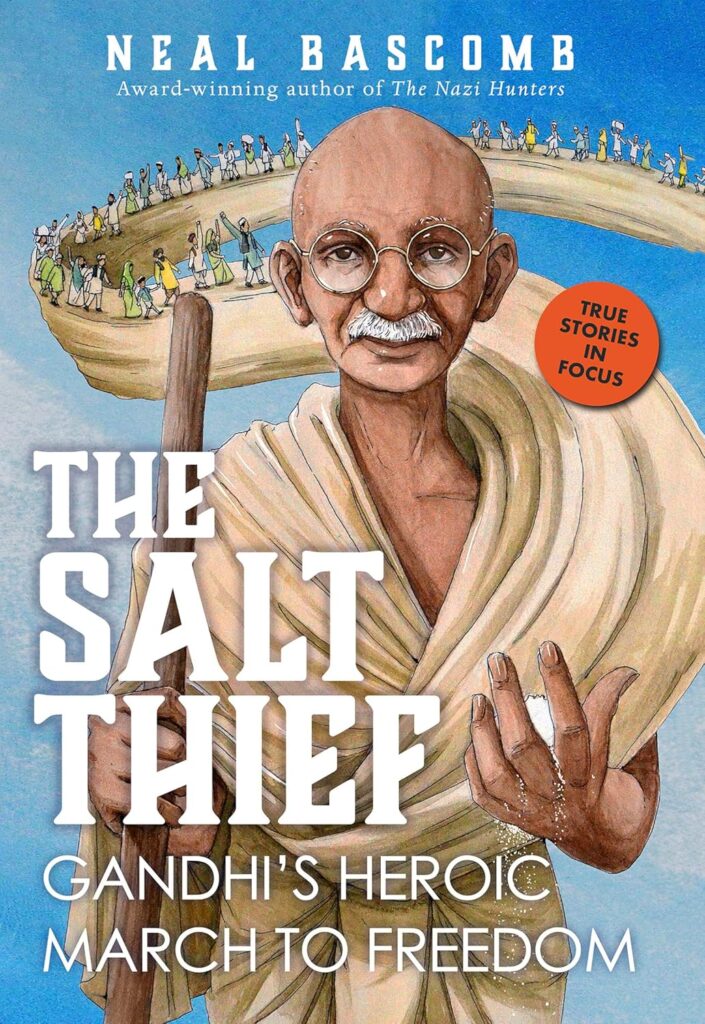

Junior Library Guild Selection
The Salt Thief: Gandhi’s Heroic March to Freedom
The dramatic story of Gandhi and India’s long march to freedom by award-winning author Neal Bascomb.
In 1930, the Indian people, long ruled by their British occupiers, were at a breaking point. No more could many stand the terrible demands of colonial rule. At this pivotal moment, Mohandas Gandhi, who had suffered firsthand for decades the cruelty of his oppressors, saw an opportunity to win his people’s freedom. And so, Gandhi led a small band of his followers on a grueling march from his ashram in western India to the Arabian Sea. After 24 days and 241 miles under a withering sun, the marchers arrived on the Dandi seashore. There, Gandhi scooped up a handful of salt to protest the much-hated British salt tax, demonstrating to the world the injustice of Britain’s yoke and setting the stage for a popular national uprising.
In the dramatic months that followed, Gandhi led acts of nonviolent resistance against the British Raj across the country that would eventually culminate in a brutal crackdown. But Gandhi and those who bravely stood with him faced arrest, beatings, and even bullets without ever raising a hand in retaliation.
These events inspired India to demand its liberty from Britain, awakened the world to a movement that would forever change the course of history, and inspired generations of freedom fighters all over the globe.
Award-winning author Neal Bascomb chronicles what was arguably Gandhi’s most notable campaign in his struggle for India’s independence. His focus on nonviolent protest and revolutionary action introduces young readers to a pivotal historical moment with timely implications for today’s world.
Reviews
“Eye-opening narrative nonfiction!” – Booklist
How did your travels to India aid you in your research and writing process for this book? What was your favorite part of your travels in India?
A decade ago, I first traveled to India. Over four weeks, I was not only awed by the majesty of the country but also fascinated by the mix of views of Gandhi, some positive, some negative, but everybody on the street had an opinion. For one of the founding fathers of the modern India state, this divergent range of opinions would be akin to a heated debate on our own George Washington. This inspired me onto a deep dive into Gandhian history, and over subsequent journeys there, I came to focus on the Salt March, as it encapsulated his life and philosophy in a single dramatic event, and yet had never been taken up by a book of popular non-fiction. The march is a coda on his whole life.
Was there anything you discovered while doing research for this book that surprised you? Why?
Put simply: Gandhi was absent from the scene of the Salt March at its most critical point. In most summaries of this inflection point in Indian independence, there is Gandhi, scooping up his fistful of salt on the beach in Dandi, embarking his people on a campaign of freedom. Yes, this occurred, but it’s the days and weeks afterward that gave true strength to the movement, and at that point, Gandhi had been arrested and imprisoned. In fact, it was a woman, Sarojini Naidu, the famous poet and gallant Congress leader, who spearheaded the third act of the Salt March, the dangerous raid on the Dharasana Salt Works that truly brought the Indian struggle to the world’s attention.
What was the hardest part of this book to write? What was the most fun to write?
The most challenging part of writing THE SALT THIEF was undoubtedly distilling millennia of history of Indian subcontinent history (as well as Gandhi’s biography prior to the events) down to a few short pages each. Obviously, it’s important context. There are whole library shelves filled with books on these intertwined subjects. But I didn’t want to write a 1,000-page tome. I wanted a fast, dramatic narrative that YA readers devoured, but also offered important insight into Gandhi and his non-violent methods.
Onto the most fun part of THE SALT THIEF…. writing about the colorful cast of individuals who surrounded Gandhi during this seminal moment in world history. Often, they are cast to the sidelines of the history. I wanted them from and center, including Naidu, of course, but also Gandhi’s family (namely his wife Kasturba as well as his son Manilal, who was particularly instrumental), a young Jawaharlal Nehru, and finally the individual marchers, high born and low, who joined their Mahatma on the long arduous trek to the sea.


